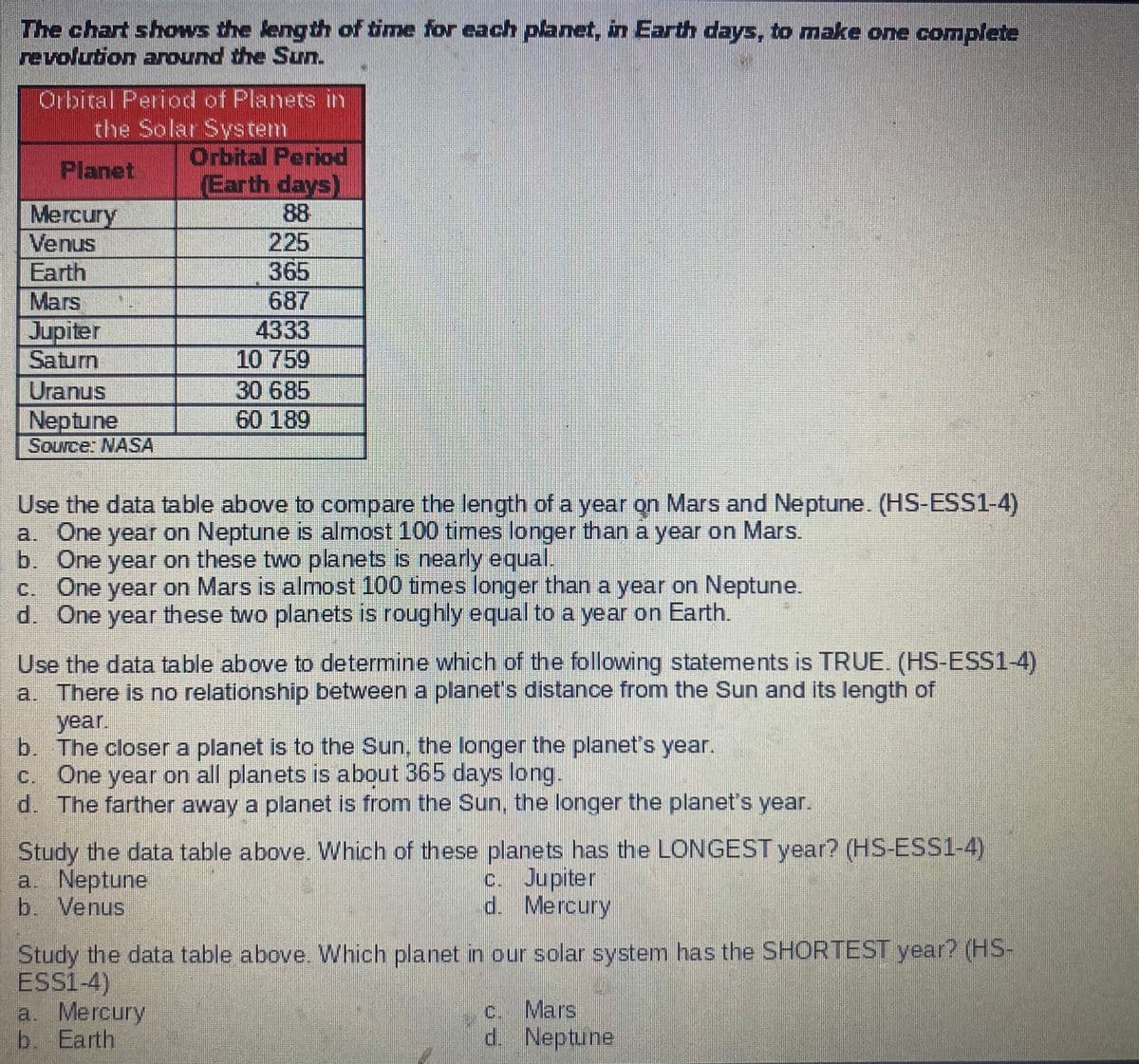The chart shows the length of time for each planet, in Earth days, to make one complete revolution around the Sun. Orbital Period of Planets in the Solar Sys tem Orbital Period (Earth days) 88 Planet Mercury Venus 225 Earth 365 Mars 687 Jupiter Saturn 4333 10 759 Uranus 30 685 Neptune Source: NASA 60 189 Use the data table above to compare the length of a year on Mars and Neptune. (HS-ESS1-4) a. One year on Neptune is almost 100 times longer than à year on Mars. b. One year on these two planets is nearly equal. C. One year on Mars is almost 100 times longer than a year on Neptune. d. One year these two planets is roughly equal to a year on Earth. Use the data table above to determine which of the following statements is TRUE. (HS-ESS1-4) a. There is no relationship between a planet's distance from the Sun and its length of year. b. The closer a planet is to the Sun, the longer the planet's year. c. One year on all planets is about 365 days long. d. The farther away a planet is from the Sun, the longer the planet's year. Study the data table above. Which of these planets has the LONGEST year? (HS-ESS1-4) a. Neptune b. Venus c. Jupiter d. Mercury
The chart shows the length of time for each planet, in Earth days, to make one complete revolution around the Sun. Orbital Period of Planets in the Solar Sys tem Orbital Period (Earth days) 88 Planet Mercury Venus 225 Earth 365 Mars 687 Jupiter Saturn 4333 10 759 Uranus 30 685 Neptune Source: NASA 60 189 Use the data table above to compare the length of a year on Mars and Neptune. (HS-ESS1-4) a. One year on Neptune is almost 100 times longer than à year on Mars. b. One year on these two planets is nearly equal. C. One year on Mars is almost 100 times longer than a year on Neptune. d. One year these two planets is roughly equal to a year on Earth. Use the data table above to determine which of the following statements is TRUE. (HS-ESS1-4) a. There is no relationship between a planet's distance from the Sun and its length of year. b. The closer a planet is to the Sun, the longer the planet's year. c. One year on all planets is about 365 days long. d. The farther away a planet is from the Sun, the longer the planet's year. Study the data table above. Which of these planets has the LONGEST year? (HS-ESS1-4) a. Neptune b. Venus c. Jupiter d. Mercury
Physics for Scientists and Engineers: Foundations and Connections
1st Edition
ISBN:9781133939146
Author:Katz, Debora M.
Publisher:Katz, Debora M.
Chapter7: Gravity
Section: Chapter Questions
Problem 12PQ
Related questions
Question

Transcribed Image Text:The chart shows the length of time for each planet, in Earth days, to make one complete
revolution around the Sun.
Orbital Period of Planets iY
the Solar System
Orbital Period
(Earth days)
88
225
365
687
4333
10 759
30 685
60 189
Planet
Mercury
Venus
Earth
Mars
Jupiter
Satum
Uranus
Neptune
Source: NASA
Use the data table above to compare the length of a year on Mars and Neptune. (HS-ESS1-4)
a. One year on Neptune is almost 100 times longer than a year on Mars.
b. One year on these two planets is nearly equal.
c. One year on Mars is almost 100 times longer than a year on Neptune.
d. One year these two planets is roughly equal to a year on Earth.
Use the data table above to determine which of the following statements is TRUE. (HS-ESS1-4)
a. There is no relationship between a planet's distance from the Sun and its length of
year.
b. The closer a planet is to the Sun, the longer the planet's year.
c. One year on all planets is about 365 days long.
d. The farther away a planet is from the Sun, the longer the planet's year.
Study the data table above. Which of these planets has the LCONGEST year? (HS-ESS1-4)
a. Neptune
b. Venus
c. Jupiter
d. Mercury
Study the data table above. Which planet in our solar system has the SHORTEST year? (HS-
ESS1-4)
a. Mercury
b. Earth
Mars
d. Neptune
C.
Expert Solution
This question has been solved!
Explore an expertly crafted, step-by-step solution for a thorough understanding of key concepts.
This is a popular solution!
Trending now
This is a popular solution!
Step by step
Solved in 3 steps

Knowledge Booster
Learn more about
Need a deep-dive on the concept behind this application? Look no further. Learn more about this topic, physics and related others by exploring similar questions and additional content below.Recommended textbooks for you

Physics for Scientists and Engineers: Foundations…
Physics
ISBN:
9781133939146
Author:
Katz, Debora M.
Publisher:
Cengage Learning


Stars and Galaxies (MindTap Course List)
Physics
ISBN:
9781337399944
Author:
Michael A. Seeds
Publisher:
Cengage Learning

Physics for Scientists and Engineers: Foundations…
Physics
ISBN:
9781133939146
Author:
Katz, Debora M.
Publisher:
Cengage Learning


Stars and Galaxies (MindTap Course List)
Physics
ISBN:
9781337399944
Author:
Michael A. Seeds
Publisher:
Cengage Learning


Foundations of Astronomy (MindTap Course List)
Physics
ISBN:
9781337399920
Author:
Michael A. Seeds, Dana Backman
Publisher:
Cengage Learning

Astronomy
Physics
ISBN:
9781938168284
Author:
Andrew Fraknoi; David Morrison; Sidney C. Wolff
Publisher:
OpenStax